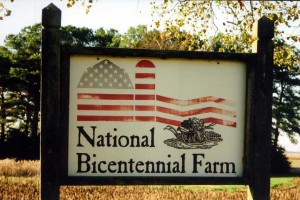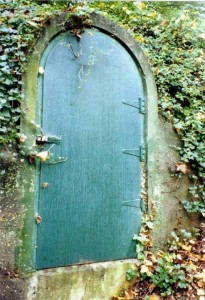Earth Day 2013 is April 22.
The View from Taylor’s Bridge – The Delaware Wild Lands Perspective
On a crisp, blue October day in 2007, I stood gazing from Taylor’s Bridge out across the pristine Blackbird Creek watching it timelessly meander through cord grass bending in the breeze. Up close, my eye caught a cluster of rare, treasured native cattails huddled among the waving Phragmites. The dense population of Phragmites in these marshes has crowded out the once abundant cattails. Muskrats eat the tender cattail roots. Until the middle of the 20th century muskrat trapping here was widespread and lucrative. Trappers sold the furs to the Hudson Bay Fur Company and placed the skinned, cooked meat on the family dinner table – not too gamey with gravy and seasonings, they say. Then the character of the marshes changed. They became saltier and overrun with the non-native Phragmites having roots too tough for the now sparse muskrats to chew.
The Blackbird landowners were farmers, loggers, trappers, and hunters. A hardy breed, living in that remote, wet area where the Delaware Bay meets the Delaware River, they respected the value of the land and practiced good local stewardship.
Leaning over the rail of that low bridge, I looked down at the dark water and watched fish leap and make whirlpools that glinted in the inrushing tide. I wondered at the view had not a group of concerned citizens such as conservationist Edmund H. (Ted) Harvey, founder of Delaware Wild Lands, Inc., farmers like Jack Dukes, Governor Russ Peterson and others rushed in to wage a 10-year battle, finally saving 5,000 acres of untouched, varicolored salt marsh and agricultural land within a reed’s breadth of Shell Oil’s planting a wild entanglement of refinery towers, belching smokestacks and pipelines there.
How different would have been the view: Other oil and shipping companies joined the opposing forces. The conservationists were up against big players – George H. W. Bush, Richard Nixon; and, yes, Maurice Stans. In the middle of the Delaware Bay shipping terminals, islands piled high with mountains of coal, would sit where schooners piled high with mountains of oysters once sailed in prime fishing grounds. The coast from north of Bombay Hook to south of Prime Hook, both National Wildlife Refuges, along the Delaware Bay would have become another Marcus Hook, Pennsylvania, just north of the Delaware state line, where malodorous refineries have rooted themselves along the river banks as dense as Phragmites.
“In the beginning [Delaware Wild Lands] were like stamp collectors,” said Holger H. (Rusty) Harvey, Delaware Wild Lands, Inc., executive director, from his office in Odessa’s historic Old Academy building. We bought checkerboard parcels of land so that Shell couldn’t use the land in between, pieces with the idea of slowing them down, to block access to fresh water. That really did it — big time,” said Harvey. “It stopped Shell cold in its tracks.” Delaware Wild Lands now owns about 4,000 acres around Taylor’s Bridge. Finally, the passing of former Governor Russell Peterson’s Coastal Zone Act in 1971 stopped Shell for good. Shell put up all the land for sale and Delaware Wild Lands bought most of it in partnership with the state of Delaware.
The strategic holdings of Delaware Wild Lands are protected long-term. Funds come through an endowment and tax-deductible contributions. They buy tillable acreage on which they administer land husbandry and game management.
Delaware Wild Lands, Inc., “is a private, non-profit, tax-exempt organization dedicated to the conservation and preservation of natural areas through the acquisition and management of strategic parcels of land.” Rusty Harvey, Ted’s son, became executive director after Ted’s death in 1978.
“My father was a man of incredible foresight,” said Rusty. “I’ve never known anybody like him. He finds a way to make people like him.” For example, it didn’t take Ted long to raise $80,000 to purchase the Great Cypress Swamp in Sussex County, when he told the Wilmington Garden Club women about the beautiful white-fringed orchids growing there.
When Ted Harvey was a boy, his dad took him around to see the state, fishing and enjoying the wildlife, instilling in him a deep respect for nature. Ted became an airplane pilot. He lived many years in Florida – between Key West and Key Largo. He had a fishing lodge there. “In 1933 they had solar power and air conditioning,” said Rusty. When Ted came back and saw the changes in Delaware, he was shocked and saddened at how real estate development had changed the landscape. Places he had visited as a child were no longer recognizable. He got friends interested to save the land before it was gone.
“We didn’t like the idea of being overrun,” said Jack Dukes. “They were going to dredge Cedar Swamp.”
A skeleton forest, the white cedar swamp at the mouth of the Blackbird that Shell wanted to dredge, is the sole New Castle County remnant of Atlantic white cedar. In 1878, the Blackbird, once primarily fresh water, now a tidal marsh, with an abundant growth of cedars, changed in character literally overnight when, during a fall hurricane, what the locals called a tidal wave breached the barrier beach, inundating the cedars. The previously protected inner marshes have since been subject to tidal action and salinity. The slow meandering of the Blackbird Creek from its headwaters in the Blackbird State Forest is the prime factor in keeping the water pristine.
Three bald eagle nests are located near where the Blackbird meets the Delaware River. There, on Mill Island “Before the Revolutionary War, the Tidewater Mill ground grain and timber,” said Dukes.
Jack Dukes committed land early to permanent farmland preservation. And in 1987 the U.S. Department of Agriculture designated the Dukes farm a National Bicentennial Farm. To be so designated, the farm must be in the family for 200 years, and not all such farms are chosen. They must meet additional standpoints.
“It’s a magical place down there on the Blackbird,” said Rusty Harvey. “I’ve never seen anything like it. The long flight of the red knot [in the spring from Chile to the Arctic to breed] amazes me. They stop in this area to feed on horseshoe crab eggs and double their body weight. It took me damn near ten years to do that.”
—Samantha Mozart
Sadly, Rusty Harvey passed away unexpectedly in May 2010, and we lost
Jack Dukes in March 2009. He was an eighth generation farmer on the family farm at Taylor’s Bridge and was an avid hunter, trapper and conservationist.
Gov. Russell W. Peterson passed away in February 2011.
To learn more about Delaware Wild Lands, visit www.delawarewildlands.org or see them on Facebook.
I excerpted and edited this story from a story I published in the December 2007 issue of Middletown Life Magazine, “The Blackbird: The View from Taylor’s Bridge.”
I thank my friend Michael Oates (302 Stories), Emmy-winning video documentarian, for connecting me to the research sources he used for his beautiful video documentary, “The Blackbird.” Through Mike’s generosity, I had the honor of meeting Rusty Harvey, Jack Dukes and other tireless wild lands preservationists, so I could write this story of the inception and continuing efforts to preserve the land and our environment under the Coastal Zone Act.













Like!
Thank you, R.
O thank heavens for those hardy folks who did all they could to preserve the natural wetlands and marshes! My metaphorical hat is tipped towards them and I bow before such fine folk.
Lovely post thank you Samantha and the photographs are beautiful!
Yes, I cannot thank them enough, Susan. They fought for many years what felt to them like a losing battle. But they stuck to it, despite how it could hurt their careers. Delaware’s was the first Coastal Zone Act in the States. It set the precedent; but, despite that, there are lots of loopholes making it easy for a developer or a manufacturer (chemicals, oil and the like) to worm their way in; so the vigilance and efforts to protect the environment are ongoing, involving lots of legal disputes.
Thanks. And I could spend days there along the Blackbird, and its neighboring creek through the marshlands, the Appoquinimink, taking photos. It IS a beautiful, pristine, area, that hopefully will remain so.